Types of Yellow Mushrooms (with Pictures) – Identification Guide
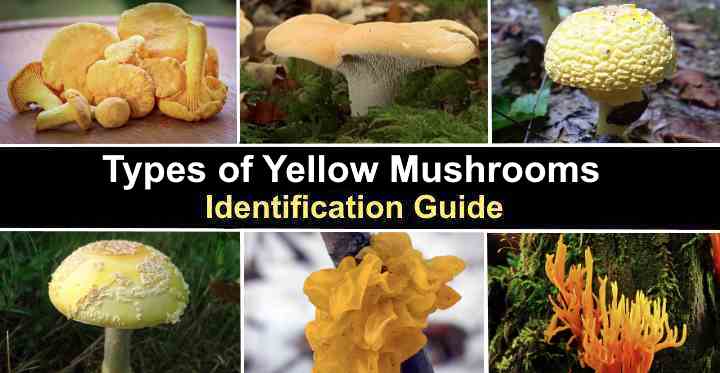
Yellow mushrooms commonly grow in front or backyards and seemingly appear from nowhere. You can find yellow mushrooms growing in lawns, flower beds, under shrubs, in forests, and on rotting tree trunks. The yellow fruiting bodies can have cylindrical stems, dark or light-colored gills, and a flattened or rounded cap.
Some varieties of yellow mushrooms, like golden chanterelles and yellow oyster mushrooms, are edible. However, many varieties of yellow fungi are poisonous, and eating them can result in severe gastrointestinal upset. Additionally, some yellow mushroom look-alikes like jack-o-lanterns resemble edible varieties like chanterelles.
This article is a basic guide for identifying common yellow mushrooms in yards, lawns, and woodlands. It does not provide advice on distinguishing edible yellow mushrooms from poisonous ones. Foraging mushrooms for consumption requires expertise and experience. The National Capital Poison Center warns you should “never pick and eat wild mushrooms unless they’ve been identified by an expert.”
Why Yellow Mushrooms Grow in the Yard
Yellow mushrooms grow in yards when conditions are right. Yellow mushrooms grow vigorously in soil with plenty of organic matter and in damp conditions, warm temperatures, and high humidity. They flourish in damp soil under decomposing leaves and decaying plant material. You may also find spongy yellow mushrooms growing on trees.
It’s good to note that finding yellow mushrooms in your yard indicates that the soil is healthy and rich in organic matter. Having conditions encouraging diverse yellow mushroom species to flourish adds biodiversity to your yard’s ecosystem.
Yellow Mushrooms in the Lawn
Yellow mushrooms thrive in lawns due to favorable conditions such as moisture, decaying organic matter, and shade provided by grass. Fungi form a symbiotic relationship with grass roots, aiding nutrient absorption. Lawns offer an ideal environment for these vibrant fungi to sprout and contribute to the ecosystem.
Common types of yellow mushrooms you are likely to find in lawns include yellow fieldcaps (Bolbitius titubans), golden chanterelles (Cantharellus cibarius), golden waxcap (Hygrocybe flavescens), golden spindles (Clavulinopsis fusiformis), and jack-o-lanterns (Omphalotus illudens).
Related reading: How to get rid of mushrooms in a lawn.
How to Identify Yellow Mushrooms
To identify a yellow mushroom, mycologists examine the shape, color, texture, and appearance of gills under the cap. Many mushrooms have a skirt-like ring on the stem. You can also tell a lot about a yellow mushroom species by the stalk’s appearance and odors the yellow fungi emit. Also, some yellow mushrooms change color when bruised or cut.
Types of Yellow Mushrooms (with Pictures): Identification Guide
Let’s look in detail at the diverse range of fungi species with yellow, canary-colored, or golden-yellow stems and caps.
Golden Chanterelle Mushroom (Cantharellus cibarius)
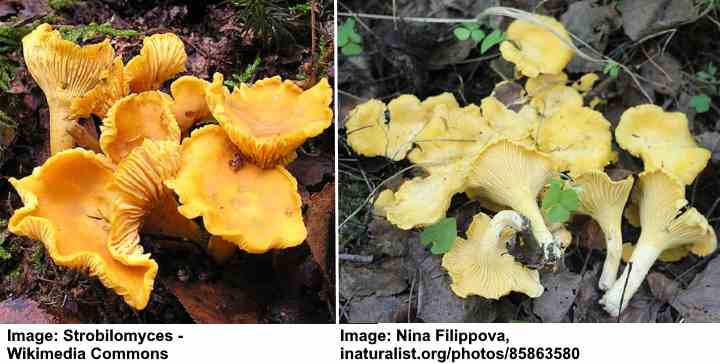
Golden chanterelle mushrooms vary in color and can be dark yellow-orange or pale yellow
The golden chanterelle is an edible wild mushroom with a vibrant golden-yellow color. Identifying features of the tasty yellow mushroom are its vase-shaped, upturned cap, wavy margins, yellowish gills, and apricot-like aroma. Also called girolles, the fungi grow 1” to 3” (2.5 – 7.5 cm) tall, with a cap up to 4” (10 cm) wide.
Golden chanterelles are often found in lawns, forests, and naturalized areas. The vibrant pale yellow to dark yellow-orange mushrooms appear in late summer to late fall. In some cases, red dots appear on the caps if the mushroom is damaged.
Golden chanterelles have poisonous look-alikes called jack-o-lantern mushrooms. Therefore, you must be careful when foraging for the yellow-orange mushrooms.
Mud Puppy Mushroom (Cantharellus californicus)
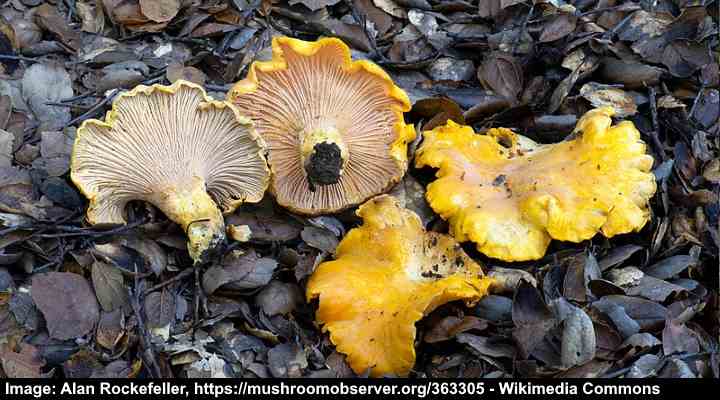
The mud puppy is a type of creamy-yellow to bright-yellow wild mushroom native to North America. The yellow mushroom is characterized by caps in an irregular vase shape and pale gill-like ridges on the stem. These yellow woodland mushrooms grow 2 to 12” (5 – 30 cm) tall.
You will often find mud puppy mushrooms growing near streams or in wet habitats. Also called oak chanterelles, the orange-yellow mushroom species is found sprouting near oak trees. It’s a popular edible mushroom in the western United States.
Yellow Fieldcap Mushrooms (Bolbitius titubans)

Yellow fieldcap mushrooms are a type of yellow lawn fungi. The mushrooms are easily identified by their distinctive bright yellow color, convex or bell-shaped caps, and upright, slender, whitish-yellow stems. The gills of the yellow fieldcap are initially yellow but turn brown as the mushroom ages.
Yellow fieldcaps grow 1.12” to 4.7” (3 – 12 cm) tall with a cap up to 2.5” (7 cm) in diameter. The pale yellow mushrooms are found in various habitats, including lawns, meadows, and grassy areas. They are often seen growing in clusters or scattered groups.
Flowerpot Parasol Mushroom (Leucocoprinus birnbaumii)
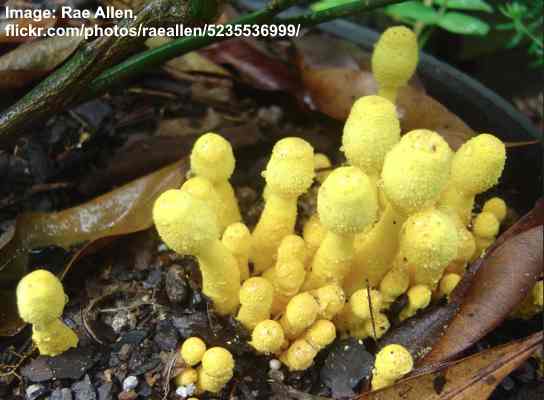
A cluster of Leucocoprinus birnbaumii mushrooms in a pot
The flowerpot parasol is a small, yellow mushroom commonly found in indoor potted plants. Also called plantpot dapperling, the yellow mushroom is identified by its distinctive bright yellow cylindrical, and sometimes flattened, cap; sulfur yellow gills, and a slender stem 1” to 3.5” (2.5 – 9 cm) long. It sometimes emits a fungus or mushroom smell.
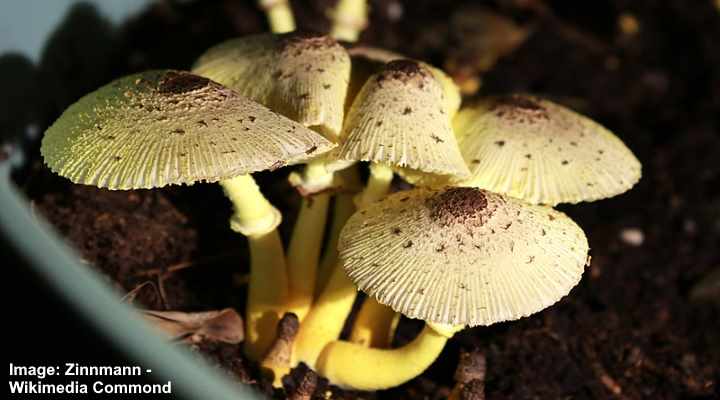
Two day old Leucocoprinus birnbaumii mushrooms in a flower pot where they develop flat caps
The flowerpot parasol grows in lawns and woodland areas in tropical regions. However, most people recognize this yellow fungus species as a common mushroom that grows in plant pots. Although it’s poisonous for humans to consume, it’s harmless to houseplants.
Golden Oyster Mushroom (Pleurotus citrinopileatus)
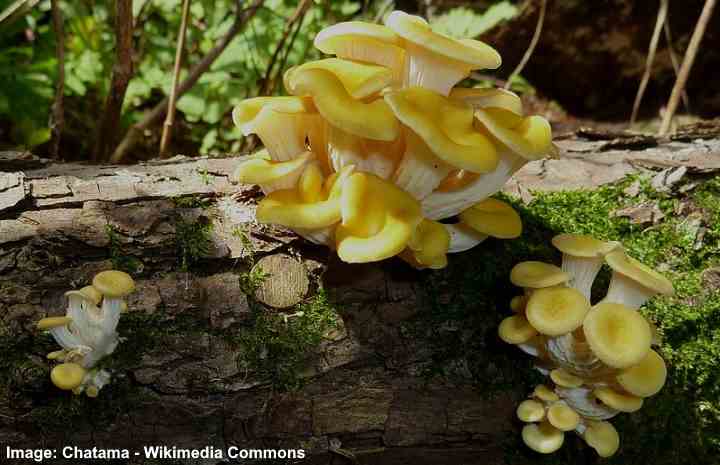
The golden oyster mushroom is a species of bright yellow mushroom characterized by its round caps with an indentation in the center. The bright yellow mushrooms grow in dense clusters with caps 0.75” to 2.5” (2 – 6.5 cm) in diameter. They often have cylindrical white curved or bent stems with widely spaced gills.
Golden oyster mushrooms typically grow in clusters on decaying wood, such as logs or tree stumps. They fruit mainly on elm trees. As they mature, they develop a distinctive funnel shape. They are easily recognizable in shape and color, contrasting with dark brown tree bark.
Golden oyster mushrooms have a delicate, mild flavor and a slightly velvety texture.
Jack-O-Lantern Mushroom (Omphalotus illudens)

The jack-o-lantern mushroom is a bright orange-yellow mushroom that looks like yellow chanterelles. The fungi grow in clusters and are identified by their convex cap that becomes funnel-shaped and closely-spaced gills covering curved stalks. The chanterelle look-alikes grow 2” to 8” (5 – 20 cm) in diameter and length.
The jack-o-lantern mushroom is also known for its bioluminescent properties. It can emit a faint greenish glow in low light conditions, especially at night, giving it its common name. You can find the mushrooms during summer and fall at the base of trees.
Chicken-of-the-Woods Mushroom (Laetiporus sulphureus)
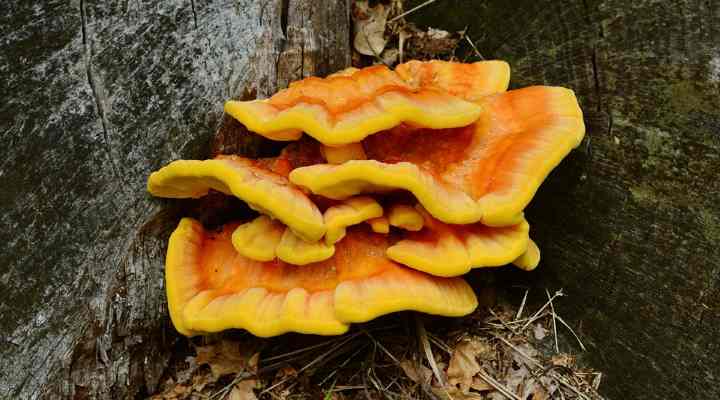
Chicken-of-the-woods is a yellow-orange bracket fungus that grows as clustered shelf-like structures on trees. This edible mushroom is identified by its large, golden-yellow, fan-shaped mushroomsdies growing up to 24” (61 cm) wide. The mushroom’s surface has a suede-like texture and exudes a fungal aroma.
The sulfur-yellow chicken-of-the-woods is common in woodlands in North America. You will find the yellow or orange fruiting bodies on several hardwood deciduous trees like willows, poplars, oaks, beech, and fruit trees.
The common name of this edible yellow mushroom—chicken-of-the-woods—refers to its chicken-like taste when cooked.
Golden Ear Mushroom (Tremella aurantia)
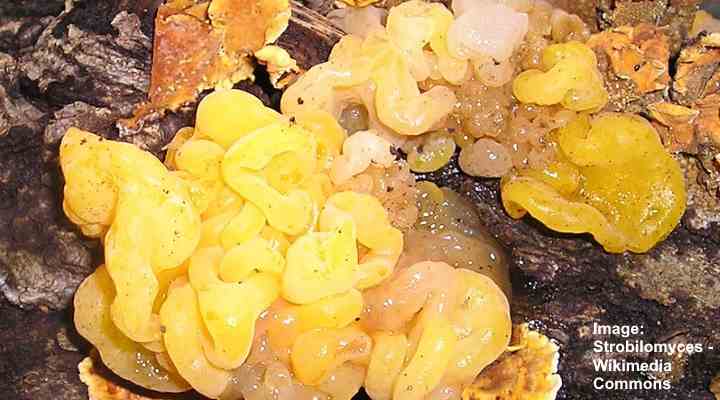
The golden ear fungus is a type of brightly-colored gelatinous mushroom that grows on decaying wood. The golden-yellow mushroom has a unique texture and appearance. It consists of dense clusters of wrinkled, folded lobes and grows 2” to 6” (5 – 15 cm) in diameter.
When mature, the golden ear mushroom turns golden brown and resembles an orange cauliflower. Although it is considered safe to eat, you must cook it before consumption.
Witch’s Butter (Tremella mesenterica)
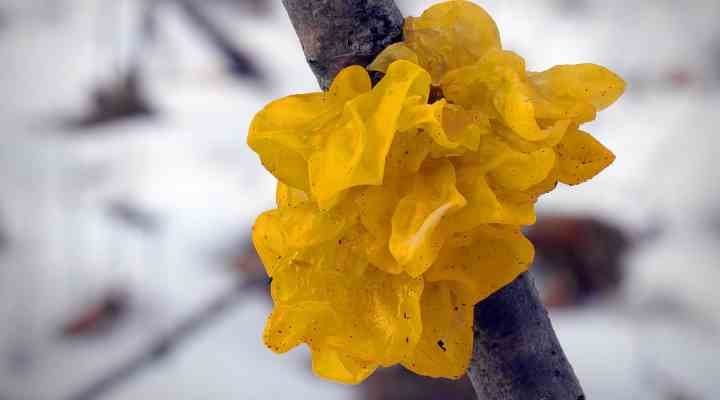
Witch’s butter is a distinctive yellow, almost translucent jelly fungus with gelatinous masses of irregular lobes. Common names for the fungus describe its appearance—for example, yellow brain, yellow trembles, and golden jelly fungus. The fruiting bodies grow 3” (7.5 cm) in diameter and are found on decaying wood.
Witch’s butter resembles the golden ear mushroom and is related. The differences between the two are that witch’s butter has a greasy or shiny appearance and has thinner lobes. Although it’s considered edible, not everyone agrees that witch’s butter is safe to consume.
Golden Spindles (Clavulinopsis fusiformis)
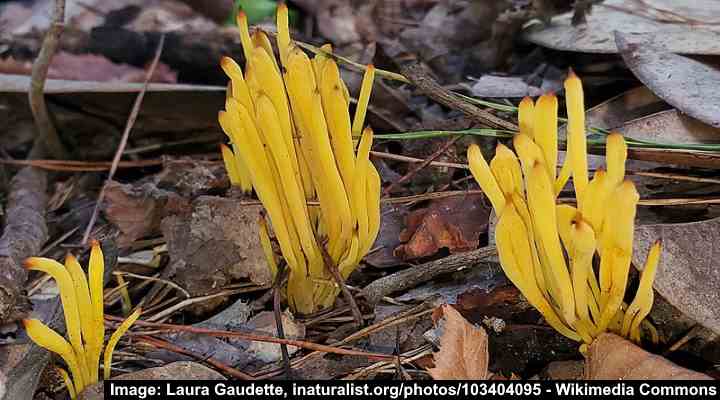
Also called yellow coral, this unusual yellow mushroom looks like clusters of spindle-shaped coral. The fruiting bodies are clusters of pencil-like golden-yellow spindles with pointed tips. The thin clubs grow 2” to 5” (5 to 13 cm) tall. The large tufts of coral-like fruiting bodies are easy to spot in a landscape.
Golden spindles are a common vibrant golden-yellow color lawn mushroom. They inhabit undisturbed grassy areas, woodlands, and forest floors. They often appear after periods of rain, and their bright color makes them stand out among the surrounding green vegetation.
Yellow Patches (Amanita flavoconia)

The yellow patches mushroom may or may not have small patches on its cap
The yellow patches mushroom is native to North America and is easily recognizable by its yellow-orange warty cap. The cap may be smooth, or covered with small flakes. This highly poisonous yellow mushroom has a pale yellow stalk, densely growing gills, and sticky yellow warts on its yellowish conical to rounded cap. The yellow-orange cap grows 1.2” to 3.5” (3 – 9 cm) in diameter.
The yellow patches look striking, with their vibrant yellow colors acting as a warning signal. The large toadstool-like fungus grows in groups or solitary near oak and hemlock trees in woodlands. It typically sprouts in late summer through fall.
Yellow American Blusher (Amanita flavorubens)
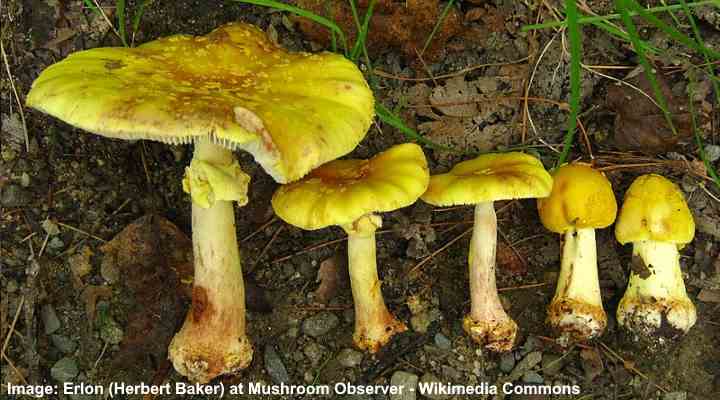
The yellow American blusher is a yellow wild mushroom with a wide disk-like cap found in North America. This mushroom is identified by its vibrantly yellow-colored cap, ranging from lemon-yellow to brass-yellow. The cap measures 1.4” to 4” (3.5 – 10 cm) wide and sits on top of a thick cylindrical stem up to 6” (15 cm) tall.
The yellow American blusher mushrooms are commonly found in hardwood forests near oak trees. The mushroom’s yellow flesh slowly stains reddish when cut. The yellow mushroom also has a shaggy appearance below the stem’s ring.
Golden Waxcap (Hygrocybe flavescens)

The golden waxcap is a beautiful bright-yellow-orange mushroom found in lawns and meadows. The rounded or flat-capped mushroom is identified by its yellow-orange waxy cap, pale yellow to orange cylindrical stem, and closely spaced pale yellow gills. The slender stem grows 1.5” to 4” (4 – 10 cm) tall, and its cap is 0.8” to 1.7” (2 – 4.5 cm) in diameter.
Yellow-orange or lemon-yellow golden waxcaps typically appear from spring through fall and grow in small groups or clusters. They prefer moist soil and are common in deciduous and coniferous forests. They often grow profusely close to beech trees.
Common Yellow Russula or Ochre Brittlegill (Russula ochroleuca)
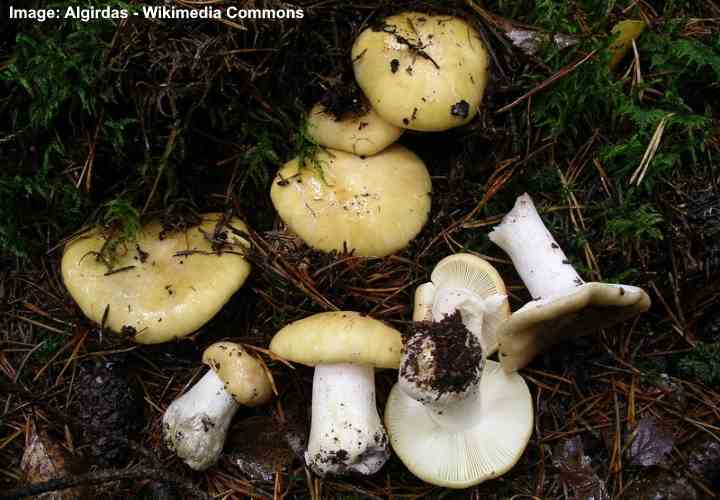
The common yellow russula is a large mushroom with a dull yellow convex or flat cap and thick white stipe (stem). The edible yellow mushroom grows 2” to 4.5” (5 – 12 cm) wide, and its stipe is 1” to 3” (3 – 7.5 cm) long.
The ochre brittlegill is similar in appearance to the yellow swamp brittlegrill (Russula claroflava), which has a convex egg-yolk yellow cap and a thick, upright, stout white stem. The yellow swamp brittlegrill mushroom is said to be tastier than the ochre brittlegrill mushroom.

The swamp brittlegrill mushroom (Russula claroflava), in the picture, is similar to the common yellow russula (Russula ochroleuca) but has a brighter yellow cap
However, it is important to properly identify this mushroom before consuming it, as some russula species can be poisonous.
Yellow Pholiota Mushroom (Pholiota flammans)
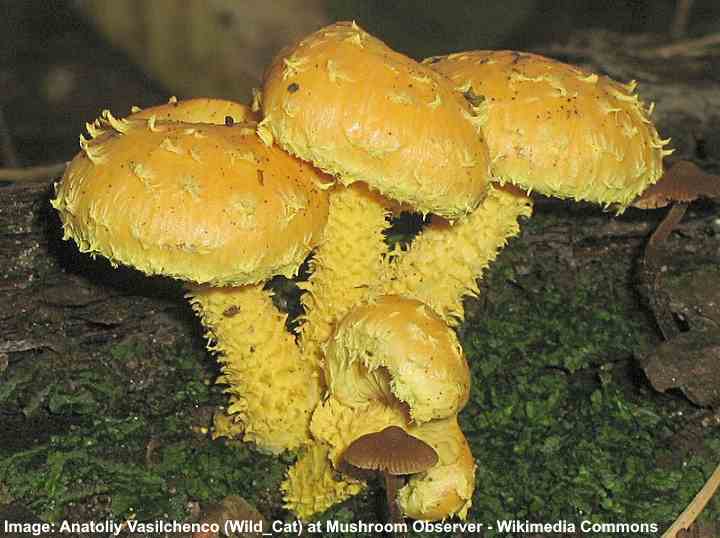
The yellow pholiota is a brightly-colored golden-yellow mushroom with an easily recognizable scaly cap and stipe. The identifying feature of the yellow fungus is its triangular spiky scales covering its surface. These are arranged in concentric rings. The mushroom has a cap with a diameter of 3.14” (8 cm) and its stem is 4.7” (12 cm) tall.
Yellow pholiota mushrooms often grow in clusters on decaying and dead wood of coniferous trees. They can grow in dense clusters or singularly and are commonly available in late summer through fall. The yellow pholiota is considered edible but is not widely sought after due to its bitter taste.
Butter-Foot Bolete Mushroom (Boletus auripes)
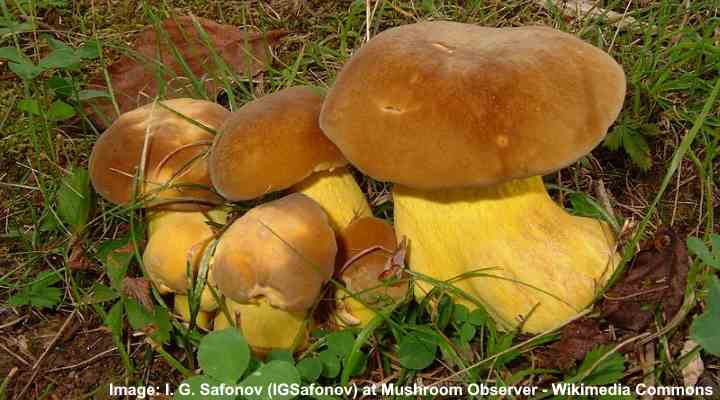
The butter-foot bolete is a type of wild mushroom with a yellow cylindrical stem and flattened brownish-yellow cap. The identifying characteristic of this large yellow mushroom is its dry, solid cap, ranging in color from pale yellow to golden brown. As it matures, the yellow flesh turns white.
The flat golden brown cap on the mature mushrooms grows 1.6” to 5” (4 – 13 cm) in diameter and has a velvety texture. You can forage for this mushroom near oak and beech trees, and it fruits from mid-summer through late fall.
Golden Scruffy Collybia Mushroom (Cyptotrama asprata)
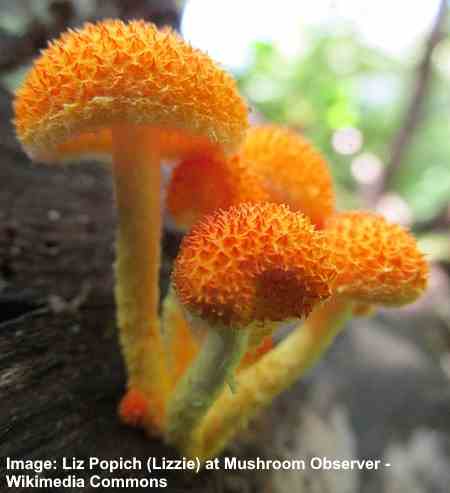
The golden scruffy collybia is easily identified by its bright yellow to orange cap covered in yellow or orange spikes. Also called spiny woodknight, the mushroom is identified by its cushion or convex-shaped cap, widely-spaced white gills, and shaggy cylindrical stipe. The bright yellow mushroom grows up to 2.6” (6.6 cm) tall, and its cap is 1” (2.5 cm) in diameter.
The golden scruffy collybia mushroom is found on the deadwood of deciduous and coniferous trees, and can be found in tropical areas of the world.
Wood Hedgehog Mushroom (Hydnum repandum)
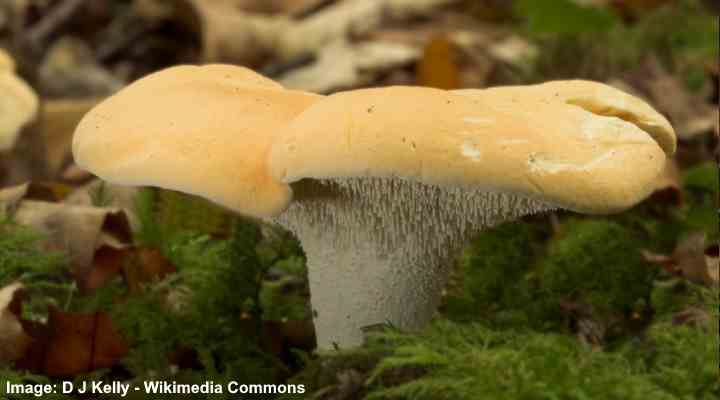
The wood hedgehog is a yellow mushroom body with an irregularly shaped yellow or tan-colored cap and a wavy margin. Also called sweet tooth mushroom, the forest mushroom has a yellowish stipe, thick white flesh, and whitish spines under the convex cap. The mushroom’s unique feature is its spines instead of gills.
Wood hedgehogs grow 1” to 4” (2.5 – 10 cm) tall with a large irregular yellow to tan cap up to 6.5” (17 cm) wide. The mushrooms grow singly or in groups on the ground of coniferous and deciduous forests.
Yellow Webcap Mushroom (Cortinarius delibutus)
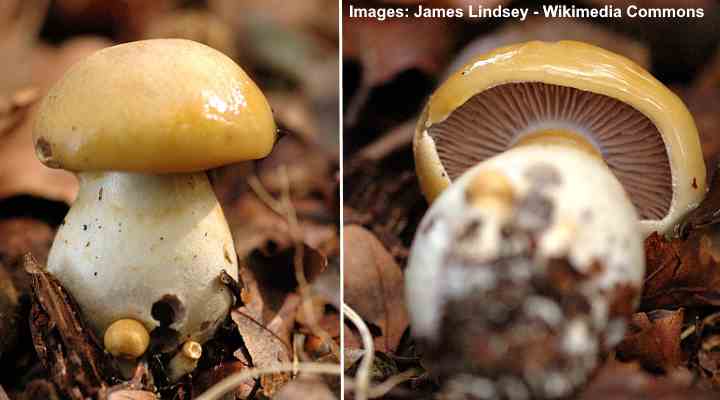
The yellow webcap is a medium-sized mushroom with a shiny, slimy dull yellow cap and white stem. The mushroom is identified by its bell-like cap that becomes flattened with age, cinnamon colored gills tightly packed under it, and a thick whitish stem with a swollen base. The yellowish mushrooms are found in deciduous woodlands in North America.
Yellow webcap mushrooms range in size from 2” to 4” (5 to 10 cm) tall, with a yellowish-brown cap measuring 1.6” to 8.1” (4 – 8 cm) in diameter.
Yellowfoot Chanterelle Mushroom (Craterellus tubaeformis)
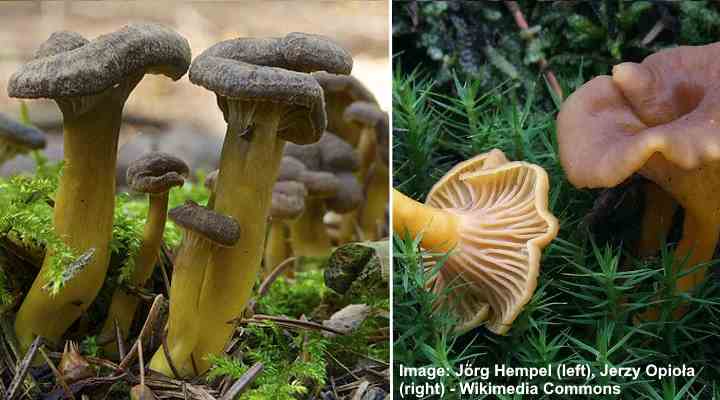
The yellowfoot chanterelle is an edible yellowish-brown mushroom, identified by its small funnel-shaped cap. Other features of the small mushroom are the cap’s wavy margin, depressed center and shallow gills, and hollow stems. The mushrooms grow up to 3.1” (8 cm) tall with a cap 0.4” to 1.5” (1 – 4 cm) wide.
The yellowfoot chanterelle mushrooms appear in groups on the forest floor or on decomposing logs.
Chicken Fat Mushroom (Suillus americanus)
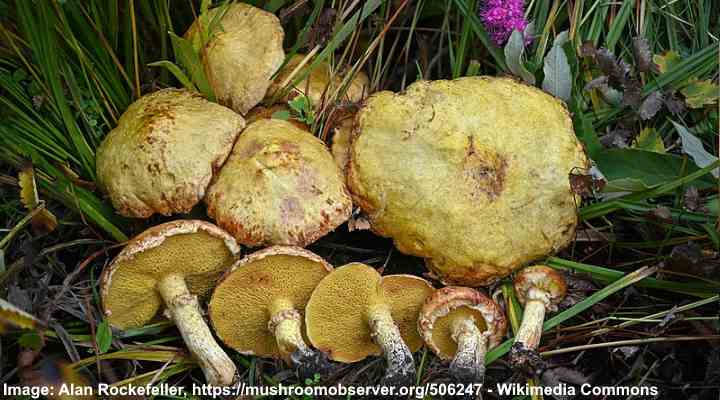
The chicken fat mushroom is a yellow mushroom with a bell-shaped to flattened cap and porous underside. Identifying features of the mushroom are the reddish or brownish streaks on the cap, crooked yellow stem, and tube-like opening underneath the cap. It grows solitary or in clusters in North American pine forests.
Chicken fat yellow mushrooms grow 1.2” to 3.5” (3 – 9 cm) tall, and its cap is 1.2” to 4” (3 – 10 cm) wide. It gets its name from its unique appearance–a greasy yellow texture resembling chicken fat. It’s also called the American slippery cap.
Related article:
